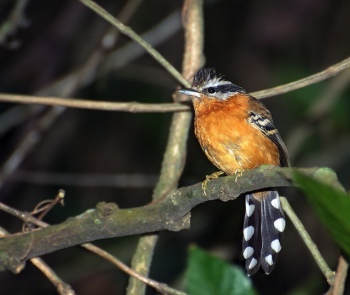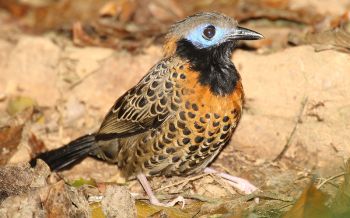Just finished working on the Typical Antbird Family. (Thamnophilidae – Antbirds) Of the 228 species, there were only 21 links when I started a few day ago, after finishing the Tyrannidae – Tyrant Flycatchers Is Complete Minus One Bird family and article. Other than 4 species that are evading me, it is almost finished. I was side-lined Sunday evening and all day yesterday with some food poisoning. Perked up enough this evening to finish it up.
The little birds that are staying out of the camera lens are the:
- Rondonia Bushbird (Clytoctantes atrogularis) Neotropical Birds
- Foothill Antwren (Epinecrophylla spodionota)
- Rio Suno Antwren (Myrmotherula sunensis)
- Slate-colored Antbird (Schistocichla schistacea)
If anyone knows where to find a photo of them, I would be obliged. Leave a comment if you know where they are hiding.
When you search the internet for photos, you have to be careful, I am finding out. Some searches show a picture on a page with the correct name, but the photo does not match the named bird. Won’t mention any names, but I will mention one of the more trusted sites that I use. IBC which is actually The Internet Bird Collection headed up, I believe by Josep del Hoyo. He and that group are quite experts in ornithology. They have been producing the Handbook of the Birds of the World. There are over 16 Volumes and counting. Their goal “has been to cover in detail and illustrate every species of bird in the world.” Now there is an undertaking, to say the least.
Back to the Antbirds. Wikipedia has this to say about them. ”
The antbirds are a large family, Thamnophilidae, of passerine birds found across subtropical and tropical Central and South America, from Mexico to Argentina. There are more than 200 species, known variously as antshrikes, antwrens, antvireos, fire-eyes, bare-eyes and bushbirds. They are related to the antthrushes and antpittas (family Formicariidae), the tapaculos, the gnateaters and the ovenbirds. Despite some species’ common names, this family is not closely related to the wrens, vireos or shrikes.
Antbirds are generally small birds with rounded wings and strong legs. They have mostly sombre grey, white, brown and rufous plumage, which is sexually dimorphic in pattern and coloring. Some species communicate warnings to rivals by exposing white feather patches on their backs or shoulders. Most have heavy bills, which in many species are hooked at the tip.
Members of this family have short rounded wings that provide good manoeuvrability when flying in dense undergrowth. The legs are large and strong, particularly in species that are obligate ant-followers. These species are well adapted to gripping vertical stems and saplings, which are more common than horizontal branches in the undergrowth, and thus the ability to grip them is an advantage for birds following swarms of army ants. The claws of these antbirds are longer than those of species that do not follow ants, and the soles of some species have projections that are tough and gripping when the foot is clenched. Tarsus length in antbirds is related to foraging strategy. Longer tarsi typically occur in genera such as the Thamnophilus antshrikes that forage by perch-gleaning (sitting and leaning forward to snatch insects from the branch), whereas shorter tarsi typically occur in those that catch prey on the wing, such as the Thamnomanes antshrikes.
Most antbirds have proportionately large, heavy bills. Several genera of antshrike have a strongly hooked tip to the bill, and all antbirds have a notch or ‘tooth’ at the tip of the bill which helps in holding and crushing insect prey. The two genera of bushbirds have upturned chisel-like bills.” (Wikipedia with editing)
It appears the Lord has created these birds with just what they need to survive in their environment. They may well be keeping the ant population in control, but some of the videos with the bird in the middle of an ant army swarm, makes you wonder who is winning.
But now ask the beasts, and they will teach you; And the birds of the air, and they will tell you; (Job 12:7 NKJV)
I know all the birds of the mountains, And the wild beasts of the field are Mine. (Psalms 50:11 NKJV)
The Bible has several things to say about the Ants:
The ants are a people not strong, Yet they prepare their food in the summer; (Proverbs 30:25 NKJV)
Go to the ant, you sluggard! Consider her ways and be wise, Which, having no captain, Overseer or ruler, Provides her supplies in the summer, And gathers her food in the harvest. How long will you slumber, O sluggard? When will you rise from your sleep? A little sleep, a little slumber, A little folding of the hands to sleep—So shall your poverty come on you like a prowler, And your need like an armed man. (Proverbs 6:6-11 NKJV)
Not being lazy and providing for yourself are two things one can learn. Also, He provides for the birds of this family by giving them an ample supply of ants and other insects, yet, they have to do the work of catching them. They are not fed directly by the Lord.
The Scripture tells us that “…my God shall supply all your need according to His riches in glory by Christ Jesus. (Philippians 4:19 NKJV). Are we suppose to sit back and just expect things to be provided for us? No, neither do the birds or animals. Yes, the Lord supplies our needs, for example, by having things grow, but they need to be picked and cooked or purchased and cooked. That is only one illustration from thousands.
Enjoy the ANTBIRD family. They are not the prettiest, but some are quite interesting.
*






Wow, that red eye really stands out.
LikeLike